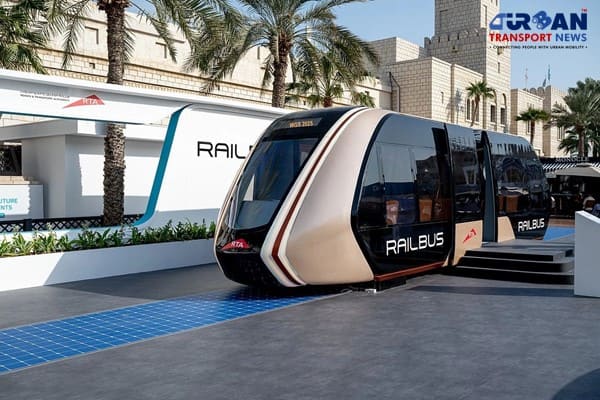 Qatar approves Saudi Rail Link Agreement, Accelerating Gulf Railway Vision 2030
Qatar approves Saudi Rail Link Agreement, Accelerating Gulf Railway Vision 2030 UP Govt plans to introduce Water Metro services in Ayodhya, Varanasi & Prayagraj
UP Govt plans to introduce Water Metro services in Ayodhya, Varanasi & Prayagraj India’s First Urban Ropeway begins Trial Run in Varanasi, Set to carry 1 Lakh passengers daily
India’s First Urban Ropeway begins Trial Run in Varanasi, Set to carry 1 Lakh passengers daily India and Bhutan to Build First-Ever Rail Link: ₹4,033 Cr Project to Boost Regional Connectivity
India and Bhutan to Build First-Ever Rail Link: ₹4,033 Cr Project to Boost Regional Connectivity Patna to launch Eco-Friendly Water Metro; Trial Run soon between Digha and Kangan Ghats
Patna to launch Eco-Friendly Water Metro; Trial Run soon between Digha and Kangan Ghats Air India Group set to launch Flights Operations from Navi Mumbai International Airport
Air India Group set to launch Flights Operations from Navi Mumbai International Airport Chennai to launch 25-Year Mobility Plan with Unified QR Ticketing and One-App Transit System
Chennai to launch 25-Year Mobility Plan with Unified QR Ticketing and One-App Transit System Kochi Metro bags ₹4.4 crore contract to prepare DPR for Mumbai Water Metro Proejct
Kochi Metro bags ₹4.4 crore contract to prepare DPR for Mumbai Water Metro Proejct Navi Mumbai International Airport set for September launch; IndiGo and Akasa Air to lead Operations
Navi Mumbai International Airport set for September launch; IndiGo and Akasa Air to lead Operations Noida International Airport to be Inaugurated on October 30, Commercial Flights in 45 Days
Noida International Airport to be Inaugurated on October 30, Commercial Flights in 45 Days
How green mobility can help world to achieve zero emission goals?

Green urban mobility refers to the concept of providing sustainable and environmentally friendly transportation solutions within urban areas. It focuses on reducing the environmental impact of transportation systems in cities while improving accessibility, efficiency, and the quality of life for urban residents. Green urban mobility encompasses various strategies and initiatives aimed at promoting sustainable transportation modes and reducing reliance on fossil fuel-powered vehicles.
Green mobility plays a crucial role in helping the world achieve its zero-emission goals. Here are some ways in which green mobility contributes to reducing emissions:-
1. Public Transportation: Promoting and improving public transportation systems, such as buses, trams, subways, and trains, to provide efficient, reliable, and affordable alternatives to private car usage. This encourages people to choose public transit for their daily commuting needs, reducing traffic congestion and emissions.
2. Active Transportation: Encouraging and enhancing walking, cycling, and other non-motorized forms of transportation within cities. Developing pedestrian-friendly infrastructure, dedicated cycling lanes, and bike-sharing programs can make active transportation more attractive and convenient, reducing the reliance on cars for short-distance trips.
3. Electric Mobility: Promoting the use of electric vehicles (EVs) for urban transportation. Electric cars, bikes, and scooters produce zero tailpipe emissions, helping to reduce air pollution and greenhouse gas emissions in urban areas. Expanding the charging infrastructure and offering incentives for EV adoption are crucial for supporting electric mobility in cities.
4. Shared Mobility: Encouraging shared mobility services such as carpooling, ride-sharing, and bike-sharing. These services optimize vehicle occupancy, reducing the number of vehicles on the road, alleviating traffic congestion, and lowering emissions per passenger.
5. Smart Transportation Systems: Utilizing technology and data-driven solutions to optimize traffic management, improve transportation efficiency, and enhance the overall mobility experience. This includes intelligent traffic signal systems, real-time navigation apps, and integrated transport platforms that provide seamless connectivity across different modes of transportation.
6. Land Use and Urban Planning: Designing cities and urban areas with a focus on compact, mixed-use development that promotes shorter travel distances and supports active transportation. Creating well-connected neighborhoods with a range of amenities within walking or cycling distance reduces the need for long car trips and encourages sustainable mobility options.
7. Policy and Governance: Implementing supportive policies, regulations, and incentives to promote green urban mobility. This includes regulations on vehicle emissions, parking policies, and urban planning guidelines that prioritize sustainable transportation modes. Financial incentives, subsidies, and tax benefits can also encourage the adoption of sustainable mobility solutions.
By implementing green urban mobility strategies, cities can reduce air pollution, lower carbon emissions, improve traffic flow, enhance accessibility, and create more livable urban environments for their residents. These initiatives contribute to the overall goal of achieving sustainable and environmentally friendly transportation systems in urban areas.







